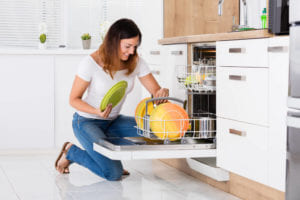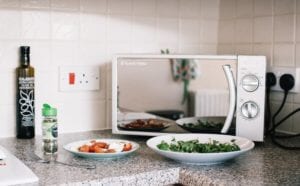Best Kitchen Knives Under $100
Choosing the best kitchen knife is crucial when it comes to preparing food, but spending hundreds of dollars may not be an option. We don’t all have that sort of money to spend on one item, but it is possible to get your hands on a decent kitchen knife for under $100 if you shop wisely.
We think we’ve found 8 of the best kitchen knives for under $100, so if you’re in the market for one, check out this review.
- High-carbon German steel
- Ergonomic design and well balanced
- Pakkawood handle for style and grip
- Lifetime warranty for peace of mind
- Rust and corrosion resistant
- Dimensions: 8 x 1.8 x 0.1
- Weight: 8 oz
- 8-inch carbon steel blade
- Ergonomic fiberglass G10 handle
- A double-edged 15-degree angle on both sides
- Liquid Nitrogen cooled for added strength and stain resistance
- Full tang
- Dimensions: 13.5 x 1.8 x 0.1
- Weight: 15.2 oz
- 8-inch stainless steel blade
- Tarnish and rust resistant blade
- Dishwasher safe (although better to hand wash for prolonged life)
- Ergonomic design for comfort during use
- Fantastic price compared to others in its class
- Dimensions: 13.9 x 2.7 x 0.5
- Weight: 10.4 oz
- Japanese high-carbon steel
- Ergonomic pakkawood handle for comfort
- 8-inch blade for multi-use
- Wear and tarnish proof, as well as corrosion resistant
- Hand polished for a super-shiny finish
- Dimensions: 13 x 0.1 x 1.8
- Weight: 7 oz
- High-carbon stainless steel
- Ergonomic pakkawood handle for grip
- The blade is corrosion and tarnish resistant
- Scores 58 on the Rockwell Hardness Scale
- Quality German made
- Dimensions: 13 x 3 x 1
- Weight: 12.8 oz
- High-carbon German steel
- Full tang
- Black pakkawood handle for style and grip
- Scores 56+ on the Rockwell Hardness Scale
- 100 percent money back guarantee
- Dimensions: 16.9 x 4.1 x 1.4
- Weight: 8 oz
- 8-inch high-carbon stainless steel
- Patented comfort grip Fibrox handle
- Lifetime warranty for peace of mind
- Ergonomic design
- Quality Swiss made
- Dimensions: 17 x 4 x 1.2
- Weight: 8.8 oz
- Warrior class German steel blade
- Black pakkawood handle for classic styling
- Perfectly balanced
- Sharpened using the Honbazuke 3-step method
- Lifetime warranty for peace of mind
- Dimensions: 12.9 x 0.9 x 1.8
- Weight: 9.9 oz
This Paudin knife is crafted from the highest quality German steel with added carbon for extra hardness. It scores 58 on the Rockwell Hardness Scale, so it should be robust enough for most tasks. It has excellent balance, is ergonomically designed to be comfortable to use, and weighs only 193g. The polished Pakkawood handle gives the knife a classic look, and because it’s rust and corrosion free, it’ll look great for years to come.
Pros
- High-carbon German steel
- Pakkawood handle
- Lifetime warranty
- Weighs just 193g
Cons
- Blade dulls quickly
- Could be sharper
This Shan Zu knife is ergonomically designed to be super-comfortable to use and features with a fiberglass G10 handle and perfect balance. The blade is made from high-carbon steel for added hardness, giving the knife a 57 score on the Rockwell Hardness Scale. For added strength, the blade is then cooled using liquid nitrogen.
Pros
- Scores 57 on the Rockwell Hardness Scale
- High-carbon steel
- 8-inch blade
- Liquid nitrogen cooled for added strength
Cons
- Can lose sharpness quickly
- The blade is thinner than others in the same class
This Utopia knife is made from 100 percent stainless steel, and because the handle has been designed to reduce hand fatigue and finger cramps, it will be comfortable to use. It’s resistant to tarnish, rust and corrosion, and because it’s a multi-purpose knife it can handle any food preparation task. And let’s not forget the price! When you compare this knife to the competition, you might ask: Why is it so cheap?
Pros
- 8-inch stainless steel blade
- Rust and tarnish resistant
- Dishwasher safe
- Great price
Cons
- Although it’s dishwasher safe, hand wash for greater longevity
- The blade chips
- Could be sharper
This Newild is made from high-carbon Japanese steel and weighs a light 7 ounces. , The handle fashioned from Pakkawood makes for a better grip, and the 8-inch blade is multi-purpose, making it an ideal “go to” knife for all your chopping tasks. It’s resistant to tarnish and corrosion as well as lovingly hand-polished.
Pros
- Anti-bacterial blade
- Japanese high-carbon steel
- Pakkawood handle
- Lightweight
Cons
- Patternation isn’t Damascus steel
- Blade dulls after a few uses
- Not dishwasher safe
Pros
- High-carbon steel blade
- Ergonomic design for comfort
- Pakkawood handle
- Quality German made
Cons
- Feels lightweight and flimsy
- The blade dulls quickly
Dalstrong is one of the leading names in the kitchen knife industry. This knife sits at the mid-way point in the pricing scale, so it’s more expensive than others in the review. It’s made from German high-carbon steel and scores an impressive 56+ on the Rockwell Hardness Scale. Dalstrong offers a 100 percent money back guarantee, so buying one should be a simple choice, especially as there’s no financial risk if you’re not happy.
Pros
- High-carbon German steel construction
- Black Pakkawood handle
- Full tang
- Scores 56+ on Rockwell Hardness Scale
Cons
- The knife isn’t as sharp as Dalstrong claims
- The blade chips too easily
This Victorinox has a patented soft-grip fibrox handle for maximum comfort. The 8-inch high-carbon steel blade is ideal for multiple uses, and the ergonomic design and lightweight feel should minimize hand fatigue. And because the Victorinox has a lifetime warranty, you can use it knowing that whatever happens, you needn’t worry about costly repairs or replacements.
Pros
- Comes with a Lifetime warranty
- Swiss made
- High-carbon stainless steel
Cons
- The blade dulls quickly
Zelite is a significant maker of popular knives. This Infinity knife is made from warrior class German steel and comes with a polished black Pakkawood handle for comfort and grip. The knife is perfectly balanced, to minimize hand fatigue, and because it is sharpened using the 3-step Honbazuke method, hopefully it will retain its cutting edge.
Pros
- Hand sharpened using traditional Japanese methods
- Pakkawood handle
- Warrior class German steel
- Lifetime warranty
Cons
- Build quality issues
- Knives aren’t as sharp as others
Kitchen Knives Under $100 Buyer’s Guide
Selecting a performance knife under $100 sounds simple, doesn’t it? But knives are expensive! Some can cost hundreds of dollars, so making the right choice comes down to some basics: Sharpness, as well as the knife’s ability to retain a cutting edge, have to be primary considerations. Sure, you will need to invest in a reliable sharpener, but you don’t want to buy a knife that needs sharpening every time you use it.
It can also be helpful to consider the following elements:
Functions
Look for a multi-purpose knife first and foremost. Don’t get into the expensive habit of buying a knife for every occasion. Second, look for the way it cuts, and how it handles. One of the primary functions should be: Is it sharp enough? If not, why spend all that money? Make sure that the cutting edge is at least 15 percent, and if it’s double-edged, even better.
Styling
A good quality kitchen knife should perform well, and look good. Some have hammered finishes, and others have patterned Damascus steel blades. Whatever you want out of your knife, don’t forget to give consideration the handle. After all, this is where you will feel the balance and comfort the most. Is it ergonomically designed for comfort and grip? The last thing you want is hand fatigue when using it. Most manufacturers use highly polished Pakkawood for the handle as it gives a classic look and an excellent grip.
Clever Technology
Modern knives are produced using the most up to date methods. Some blades are cooled using liquid nitrogen to add super-hardness and to prevent corrosion or tarnishing. But that doesn’t mean that advanced knifemaking doesn’t recognize the methods of the past: the Honbazuke 3-step sharpening method is still widely practiced today, and it is a sure-fire way of achieving a sharp blade.
Product Warranty
Luckily, when it comes to warranties, most manufacturers give you a lifetime guarantee. Now that’s pretty impressive. Imagine never having to worry about your cutting needs ever again. Of course, misusing the knife in any way will make that lifetime warranty will disappear, so make sure you look after it, especially when it comes to washing. Even if the manufacturer recommends cleaning it in a dishwasher, it’s better to hand wash the knife to prolong its useful lifespan.
Brand Reliability
It stands to reason that the brands that have sold the most significant numbers on Amazon are the brands to look at in more detail. Zelite, and Dalstrong, as well as Victorinox, have some great reviews, and a lot of happy customers. When things do go wrong, check out their responses: I’m thinking Zelite in this instance. They respond to every bad review to offer a solution. Now that builds brand loyalty. A happy customer is a happy customer, but turn around an unhappy customer, and they’ll be loyal for life.
FAQ
Can I put my knife in the dishwasher?
Yes, you can. Some makers claim that they’re dishwasher safe, however, when you read into it a little, you’ll discover that hand washing is always best for the care of your knife. Abrasive detergents and the fast jets of water can dull the blade.
What angle should the cutting edge be?
It should be 15 percent, but you can buy Asian knives that differ. Generally speaking, American and European knives are 15 to 20 percent angled. And if it’s a double-edged blade, the angle should be the same on both sides.
What is high-carbon stainless steel?
High-carbon stainless steel is an alloy containing various amounts of carbon. The amount varies depending on the manufacturer. Some steel blades have as much as 1.2 percent of carbon, while others have 0.2 percent. It all depends on how hard the maker wants the knife.












